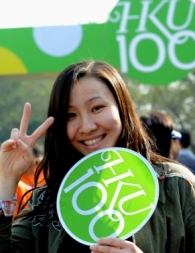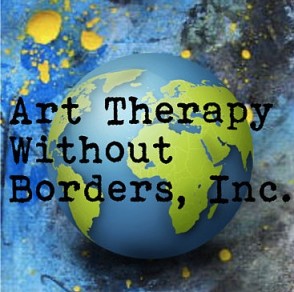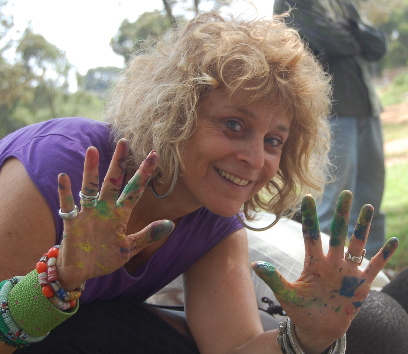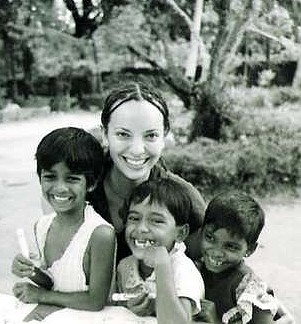During 2011, Art Therapy Without Borders will be featuring members from the Advisory Council as an opportunity to learn more about their work and some of the art therapy initiatives they are involved in that speak to this community’s vision. July’s spotlight includes Fiona Chang:
A Registered Expressive Arts Ther apist, Registered Social Worker and Trainer, Fiona Chang, REAT, RSW, M. Soc. Sc. has more than 17 years of experience integrating multimodal expressive arts processes in counseling and group therapy throughout a variety of settings in Hong Kong. Fiona is the Vice-chairperson of the “Art in Hospital” and honorary advisor of several patient self-help organizations. She is also an Honorary Lecturer of the Department of Social Work and Social Administration and Honorary Clinical Associate of the Centre on Behavioural Health of the University of Hong Kong. Fiona serves as a Regional Coordinator and a member of the International Committee of the International Expressive Arts Therapy Association (IEATA), a member of the Advisory Council of Art Therapy Without Borders (ATWB) and a member of the Southwestern College Board of Advisors. She also conducts lectures and workshops at several universities and NGOs, locally and internationally.
apist, Registered Social Worker and Trainer, Fiona Chang, REAT, RSW, M. Soc. Sc. has more than 17 years of experience integrating multimodal expressive arts processes in counseling and group therapy throughout a variety of settings in Hong Kong. Fiona is the Vice-chairperson of the “Art in Hospital” and honorary advisor of several patient self-help organizations. She is also an Honorary Lecturer of the Department of Social Work and Social Administration and Honorary Clinical Associate of the Centre on Behavioural Health of the University of Hong Kong. Fiona serves as a Regional Coordinator and a member of the International Committee of the International Expressive Arts Therapy Association (IEATA), a member of the Advisory Council of Art Therapy Without Borders (ATWB) and a member of the Southwestern College Board of Advisors. She also conducts lectures and workshops at several universities and NGOs, locally and internationally.
Tell readers a little about yourself and what your interests are in art therapy: Since I was a little girl, I loved to use art, singing, lyrics and dramatic play to express myself. I have deeply experienced the healing potential of the arts in my own personal growth and journey. I am very grateful to be an expressive arts therapist because I can do what I am really passionate about in both my personal and professional paths.
I studied a Person-centered Expressive Arts Approach with Dr. Natalie Rogers and Dr. Christine Evans at Saybrook University in the US and have integrated multimodal expressive arts processes in counseling and group therapy for nearly 18 years in a variety of settings, including but not limited to working with people with health challenges, deprived women, parents and children with special needs, ex-drug addicts and in palliative care. As a mother, I have made use of home-based arts for child development and parent-daughter communication. As a woman, I have used the arts to contain and express my true feelings in an artistic way. I always find a new sense of self from the creative exploratory process. Such profound transformation can strengthen the Person-centered quality of my true being and bring me to a solid ground in clinical practice with positive regard, empathic understanding and congruence.
 I am very interested in the blending of Chinese metaphors, art, culture, philosophy and rituals in the Western model of expressive arts therapy to actualize the self-healing potentials of each individual. For example, the “Yin-Yang Mandala” is a wonderful invitation to explore the harmony between feminine and masculine or light and shadow of our inner world. “Xinjie” 心結 is a meaningful metaphor to the knots in our heart. We can use colorful strings to make symbolic knots to represent our difficulties, inhibitions, attachment and unresolved business in life. In the creative healing process, we can discover how to release, accept and learn from each knot.
I am very interested in the blending of Chinese metaphors, art, culture, philosophy and rituals in the Western model of expressive arts therapy to actualize the self-healing potentials of each individual. For example, the “Yin-Yang Mandala” is a wonderful invitation to explore the harmony between feminine and masculine or light and shadow of our inner world. “Xinjie” 心結 is a meaningful metaphor to the knots in our heart. We can use colorful strings to make symbolic knots to represent our difficulties, inhibitions, attachment and unresolved business in life. In the creative healing process, we can discover how to release, accept and learn from each knot.
What do you believe are important considerations or emerging issues for the international art therapy community to pay attention to? With the convenience and rapid development of social media, people from different corners of the world can be connected without borders and become promptly closer to one another. The Internet has become a fascinating platform for us to share our work in the art therapy field. The creative force from each individual can become a universal energy in bringing the true essence of arts to this world. Especially in some countries, art therapy is a new comer to the human service field. Having an international exchange and support platform is really helpful for promoting the worldwide development of art therapy. To furnish this exchange with human touch and ethical sensitivity, we can infuse humanity, mindfulness and creativity in the online platform.
Healing is possible in many communities when people who are passionate about sharing the gifts of expression through the arts are supported to follow the true calling from their heart. Different communities have their unique way of using art as healing, counseling and therapy, and as a result the art therapy field will become more dynamic and challenging in this decade. With an international community walking the path of the changing world, it is vital to build up an open global family as a nurturing ground to embrace different blooming approaches, values and cultures of art therapy in this world. I do believe in the universal power of the arts to heal. Through a fruitful international exchange, we can learn from each other, respect each other, nurture cultural sensitivity and advocate for the true empowerment through the arts.
What are some special art therapy projects you are working on in 2011? With the support of Dr. Natalie Rogers, Dr. Christine Evans, Professor Jack Weller, Ms. Anin Utigaard, Dr. Sandra Tsang and Professor Cecilia Chan, I recently rolled out a Three-year Training Program in Expressive Arts Therapy – The Person-Centered Approach at the Centre on Behavioral Health of the University of Hong Kong. We just conducted two briefing sessions with more than 100 participants. We also got many enquiries from Singapore, Malaysia, Philippines, Macau and Mainland China. This is the first ever local program to train budding expressive arts facilitators, educators and therapists in Hong Kong. Our team members are excited and honored to be contributing to this development. For more details, please go to this program link.
In addition, it is valuable to put our experience in words to share and consolidate our clinical practice. I am now writing several English and Chinese book chapters on the application of expressive arts therapy in Hong Kong. Titles include “Awakening the Creative Resources of Cancer Patients”, “Using Expressive Arts to Advance Group Development” (善用人本表達藝術治療促進小組成長 in Chinese), “Integrating Person-centred Expressive Arts with Chinese Metaphors” and “Regaining Feminity from Breast Cancer with Expressive Arts”. My dream is to write my own Chinese book on Expressive Arts Therapy in 2012.

I love my clinical practice and will continue to use the arts with people from all walks of life. This year, I have been invited to go to India and Sichuan to promote the healing arts and provide training to mental health professionals in some deprived areas. We are planning to work with the local people to spread and plant the seeds of arts in their homeland.
How can people contact you or find out more about your work? I am inspired by the affection, beauty, creativity, delight, expression and freedom of arts in a person-centered approach. I hope more people can use the arts to generate energy for growth with congruence, love, faith and creativity. You can find me at www.personcenteredexpressivearts.com or reach me at fionafoo@sw.hku.hk.









![DSC01435[2]](https://arttherapywithoutborders.wordpress.com/wp-content/uploads/2011/06/dsc014352.jpg?w=225&h=300)




